Text
12. Reflective Report (in 1,000 words more or less)
I chose to focus on autism, specifically Aspergers, as the topic for my final module film, as a means to address my own struggles and difficulties with the disorder by using animation through a healing and auto-therapeutic approach. I created this film to spread greater understanding and awareness towards autism spectrum disorders; it was relatively early on in the process that I developed a strategy on how I could achieve this.
Through my studies I learned about society's general perception towards animation as a medium and how it's still fringe outside of anything that isn't aimed towards an audience of children. But also, because of this perception I also learned that animation has a unique ability to communicate taboo, unsettling or difficult topics and themes that still need a mode of expression and that animation offers this under a fabricated guise which appears more friendly or socially acceptable on the surface. Personally to me this is why animation is the problem-solving medium of the twenty first century and is best at using information to tackle relevant issues such as social media, consumerism, mental illness etc.
So for the video format I decided to make the project an informative video; presumably towards a younger adult internet-savvy audience, since the web community is rife with toxic slander and bullying towards autistic persons. The video would have a visual narrative revolving around an original voice over based on a written script.
This is inspired by the School of Life style videos on YouTube, which cover highly intellectual topics, but using novel and playful animation styles which push visual metaphors to make spoken material easier for people below the University educated level to understand. Since writing the script was the first step in the process, this was arguably the most difficult part, but it really wasn't. As soon as I overcame the initial hurdle the writing process was the easiest part.
It was only difficult at first because I had 25 years worth of memory and personal contact of backtracking with a disorder which I still cannot distinguish between my own identity. Upon realising the video would achieve more success if I were to treat it less as a self-indulgent life-story and more of a spoken essay in an attempt to give a more factual account of the symptoms and misconceptions surrounding autism. the direction of the project became less about my own ego and more of a public spirited act. I was able also to thereby build upon the existing discourses and debates surrounding it.
The difficulty with writing the script really eased up when I read a book (sorry Stu) on an authors' personal account with autism. This really enabled me to communicate the social and emotional impacts autism can have on the individual, which I was concerned would have been lost. This really helpful book was "From Another Planet; Autism from Within" by Dominique Dumortier.
In addition to this I made a word spread using material from Uta Frith's "A Very Short Introduction" on Autism. It's kind of like a mood-board, but with words. I also used image material from Google searches (what student doesn't?) as the basis for concept designs and initial research.
The audio recording became a means to tie all this together to reinforce a message; one which promotes neurodiversity and seeing autism and other development disorders as a difference, rather than a disease. My aim during this stage was to create a coherent sequence which tells a story through an animatic. In order to do this I used the script, visual research and concept designs to draft up the storyboard.
The storyboard wasn't too difficult, in fact it was one of the more enjoyable parts of the process despite still proving to be time consuming and requiring a lot of mental effort. I would soon figure out that the latter stages would get progressively worse. The most-difficult part of the entire process in actuality was the final compositing in After Effects and I'm unsure as to whether this is because it was the final step so thus felt like the longest step, or because what I anticipated would be a quick finishing job (I had made a series of animated GIFs from the visual material for this) turned out to take much longer as soon as I figured out that exporting a GIF of only 8 frames on "loop forever" does not, in fact, give you infinite footage (whoops). This resulted in me having to repeatedly copy-paste the GIF footage in the timeline which would have gotten overly-complicated if I hadn't thankfully learned about CTRL+SHIFT C by then.
The part where I had to isolate each scanned image so they all had their own transparent PNG file was a really time-consuming process as well but this was at least relatively simple and didn't require as much mental effort. For the digital colouring step which came afterwards I wanted to give each image a distinct texture to contrast the simplistic stick men line art and style. Despite the time consumption, this is one of the parts of my practice that I love the most as I love the process of experimenting with putting traditional media in a moving image context. I especially enjoyed making moving images of hills and grass rendered out of oil pastel, and the moving image sunset out of soft pastels.
The process got tedious a lot at times, which I'm sure is just the nature of working in animation, but overall, the process was really engaging and enjoyable and I'm glad I was able to work on a subject that I care very passionately about. The act of animating and playing around with visual metaphor has been really cathartic to me personally and gives me a voice as a filmmaker and artist.
The strongest advantage I see that the film has is the contrast between the quirky humorous and darker tones that it represents through the stick man style and organic render and mark making. I feel this strongly reflects my personal voice and mission as an animator to communicate the topics and themes of society's problems which aren't so easy to communicate. If I have to be critical and point out my biggest disadvantage with the film however it would probably be the difficulty in transferring traditional media to digital whilst preserving as much of the quality as possible (I noticed a lot of dead pixels around stick figure images especially over the black backgrounds, even after I tried to make up for it with the brightness and contrast settings).
0 notes
Text
11. Post-scanning process
After scanning and isolating each image so they had their own individual file and had a transparent background in PNG format, it was time to digitally colour each image. I also decided to toggle with the brightness and contrast settings on the scanned line-art layer because the line quality from the scan was noticeably grey in tone so toggling this setting made the line art as close to black as possible to make the line work “pop”, and appear to be higher quality. This also reduced the amount of dead pixels that surrounded the line work making for a more seamless finish.


Planning out the compositing in After effects:

Audio - visual diagram layout:

0 notes
Text
10. Pre-production process


For the majority of the animation, I create frame by frame animations on 2′s, so a stick character would have a back-and-forth movement that would appear to look child-like and naive. I decided to keep the ink and colour separate so I could scan the colour palettes individually and use the textures to colour characters and backgrounds digitally on a different layer.

For grass as well, I would use the storyboard template to measure the dimensions before using it as a canvas for applying traditional media such as oil pastels on. I would repeat this numerous times to give an illusion of movement made from the strokes and residue created by the tools.
At times I used a light box to assist. When everything was done I scanned everything and then isolated each image and made them transparent PNG files.
0 notes
Text
9. School of life (YouTube) Analysis
youtube
The School of Life is a channel on YouTube which hosts a series of information-based videos around many different facets of human life such as history, relationships and philosophy. The videos feature a voice over dialogue which is then emphasised further by the visual communication created by animators.
This was a major influence for helping me decide which format the film should take as I was struggling to be able to make a short film out of the topic I gave myself. Furthermore, since the mission was to spread greater awareness and understanding of autistic spectrum disorders, I wanted the audience to understand directly that the film is about autism and therefore I decided to make the film based entirely around a voice over which would explain the disorder.
0 notes
Text
8. Animatic preview stills

1. 00:00 - Bobby standing in place on the playground
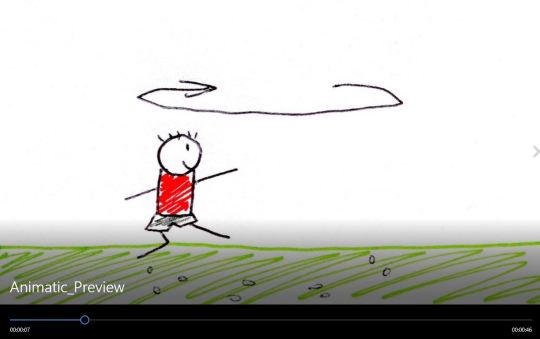
2. 00:07 - Bobby runs around in a circle

3. 00:09 - Bobby’s talents and interests

4. 00:11 - Bobby in art class

5. 00:13 - Bobby showing how organised he is

6. 00:15 - Bobby rolling down a hill on the school playground

7. 00:18 - Transition to being playful during class
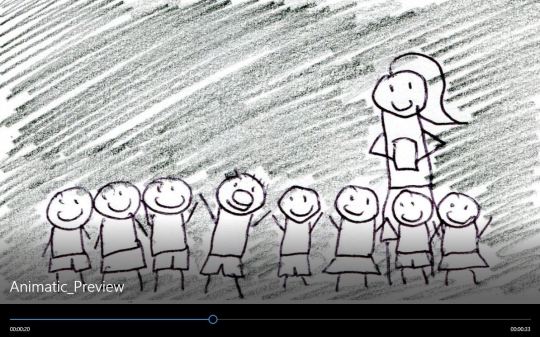
8. 00:20 - Bobby, having grown older, looking back at nostalgic school photograph

9. 00:24 - Longer/wider shot
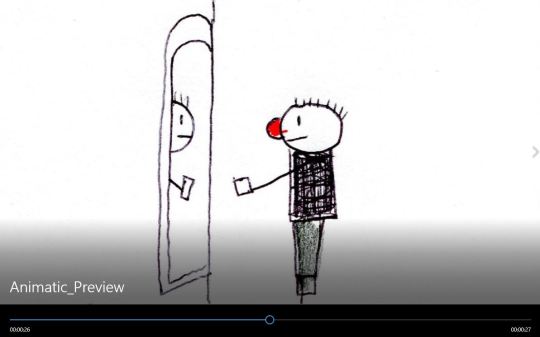
10. 00:26 - Bobby looking in the mirror

11. 00:30 - High functioning Asperger syndrome and how it’s a literal branch of Autistic spectrum disorder

12. 00:39 - Severity scale illustrated as a car gauge
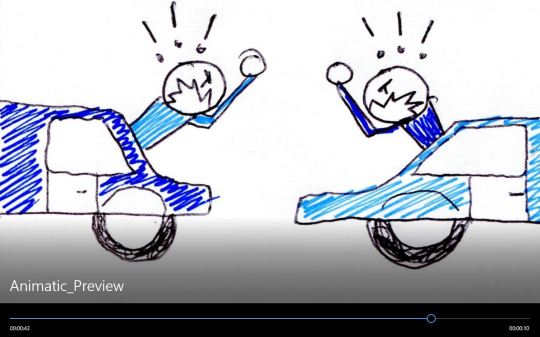
13. 00:42 - A couple of drivers getting into an argument, implying bad communication

14. 00:48 - Said drivers chasing each other to cause the other harm. Driving in circles implies getting nowhere with the interaction. It’s also repetitive, implying obsessive and restricted patterns.
0 notes
Text
7. Storyboard (Old vs Revised)

Old storyboard 1

Old storyboard 2

Old storyboard 3

Old storyboard 4

Revised storyboard 1

Revised storyboard 2

Revised storyboard 3

Revised storyboard 4

Revised storyboard 5

Revised storyboard 6

Revised storyboard 7

Revised storyboard 8

Revised storyboard 9

Revised storyboard 10

Revised storyboard 11
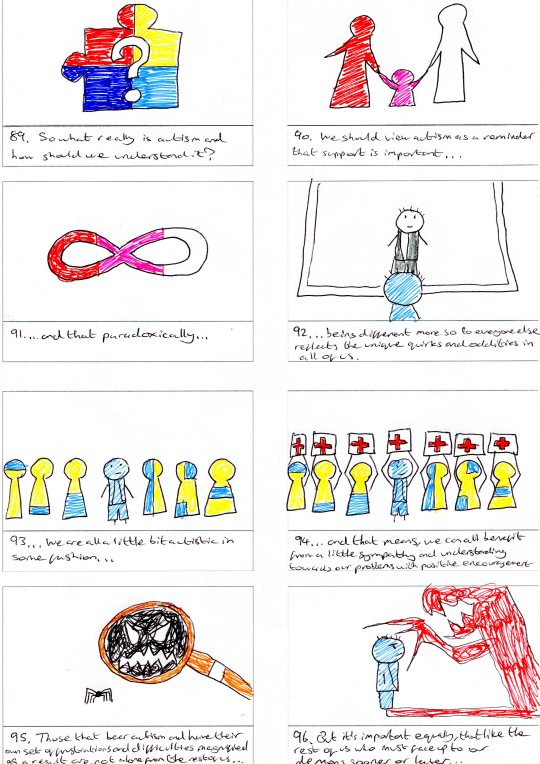
Revised storyboard 12

Revised storyboard 13
0 notes
Text
6. Full Script - Transcribed
This is a story of a young boy named Bobby. Bobby is a kind and gentle, but equally active and energetic boy of many talents. He enjoys creative subjects in school and always turns up on time. He likes to roll around in the playground, and make the other kids laugh in class. He cares about his family, teachers and friends very much. But then Bobby changed. He began to feel different to everyone else. At a very young age, Bobby was diagnosed with High Functioning Asperger's Syndrome, a subset of Autistic Spectrum Disorder. Asperger's and autism, are developmental disorders, which occupy a wide variety of different severities. This means no two people with the condition are the same. But the dominant patterns are difficulties in social interaction, communication, and restricted or repetitive patterns of thought and behaviour.
Bobby had a hard time making friends at bigger school. He got picked on for standing out as odd or different. Bobby never had the tools he needed to be able to fully articulate and express his true self. The autistic condition is an invisible one that is hidden within. It remains present, yet without making itself immediately obvious, apparent or noticeable to the naked eye. From the outside, Bobby appears to be rather normal. Therefore, one expects Bobby to make efforts to conform and fulfil the demands that come with day to day living.
His autistic condition receives little attention. So Bobby has no choice but to bear the pressure, and make every physical and psychological effort he can to “blend in” and “look normal”, at the expense of complete exhaustion and dissatisfaction, even nonacceptance, of self. The problem with navigating towards a fulfilling and high quality life of independence with autism is a complex one. The condition is lifelong, meaning it doesn’t go away. Equally, our efforts to trace its origin prior to birth have proved futile at finding a cure. Consequently, autism is not a disease which can simply “be cured”. Our best so-called “cures” are positive encouragement, intervention and therapy, with a focus on self-improvement.
There are reassuring points to autism however. Over half of high functioning people are reported to have at least average to above average intelligence. Some are talented in a specific skill, such as drawing, arithmetic or playing an instrument. Adverse symptoms also frequently loosen their grip on the bearer as they progress into early adulthood. This is great news for people with autism and their families and loved ones, but it does come with a risk of somewhat discrediting or invalidating the disorder. Bobby is doing really well academically, achieving top grades. He’s also captain of the school soft ball team; president of the chess club and a three-year running subject award winner. He’s already at grade 7 in music, has a close group of friends, and he even has a girlfriend. One may ask, having achieved so much, how Bobby could possibly be struggling.
It’s a fair question. The answer lies on the inside. It’s around his friends and peers where Bobby feels most at ease and relaxed, so they only get to see his confident side and are unaware of his struggle. They don’t know that Bobby is on an ongoing quest towards discovering his inner self; someone who feels a little bit muddled up, often feels dispirited and broken, and has grown to be far too critical to himself. On the inside secretly, Bobby feels like he’s just about had it with pushing limits and climbing mountains to mask, and compensate for his difficulties to avoid becoming a hindrance and seeking for constant approval.
Autism in society has become somewhat of a taboo. “Don’t use it as an excuse” is frequently drummed into us. It must be that Bobby is just a difficult, unmanageable and stubborn person. Perhaps he should just stop being awkward and adopt a standard of behaviour”. But Bobby can’t, not even if he wants to. It’s just not in the cards. The natural order of things don’t make sense to him. The world may not bend itself to suit Bobby, but he needs a healthy balance just as the world does, just as there needs to be sunshine as well as rain, and the change of the seasons. Bobby needs to stay true to self, as well as make compromises to meet the world half way. This is the key to responsibility.
The critics, the haters, the party-poopers and nay-sayers are probably no angels themselves. They’re fraught with their own inner demons and life problems. That’s not to say that autism is trivial, nor should we choose to cocoon and shelter our children from the frightening and unforgiving tests and trials of the outside world. Moreover, our aim should be to stamp out the stigma, refrain from the finger-pointing and lay back from the incessant labels. On the other side of the coin, we must not glorify or parade autism as a plea for special treatment or packages that would disclude them from the difficulties which all other people must naturally face. This would be a disservice and demean the efforts for the good lives bearers have worked so hard, and sacrificed so much, to create.
So what really is autism and how should we best understand it? We should view autism as a reminder that support is invaluable, and paradoxically, that being different more so than everybody else reflects back the unique quirks and talents in all of us. We’re all a little bit autistic in our own, both incomplete and gifted, ways, and that means we can all benefit from more positive encouragement. Those that bear the condition of autism, and have their own set of frustrations and difficulties magnified, are not alone from the rest of us. But it’s equally important, just as much as us all who have to face up to our own inner demons sooner or later, that autism be recognised as a hidden badge of honour for the silent battles fought from within...
0 notes
Text
5. Animation influences



World of Tomorrow - Don Hertzfeldt 2015
A huge inspiration for the tone and style for the film is Don Hertzfeldt especially from his short film World of Tomorrow. I find it very interesting how he wrote the entire visual narrative around the dialogue of his five-year-old niece, and some of the random comments she makes really adds to the humour in the film.
The world of Don Hertzfeldt is very strange, but in a positive way. It plays on the unusual, like falling in love with rocks. But it also explores some very deep and depressing themes such as the emptiness of existentialism and bereavement, which makes the film more real and authentic in its feel, and gives it a certain relatability which audience members can closely identify with.
The simplistic stick design in contrast to the textural backgrounds goes strongly well with this humour and dark contrast, and this is what I wanted to carry over in my own film and want to carry over more in my future films.



HEART animation - Mel Hani
Heart are an award winning provision that specialise in using animation in healing and therapeutic contexts. This makes the pre-production stage core to the therapeutic process, where clients are placed in the seat of the creator.
Some of the work that comes out from HEART is very interesting visually, and I decided to explore them for a little while to get ideas for new methods and materials to work with. Many of the clients are children which is why the images have the mark of being made by a child but it’s this naive style that lends itself well for being able to communicate difficult topics not normally talked about.



Asparagus - Suzan Pitt 1979
Suzan Pitt is an american animator who attempts to animate the unconscious. This makes her films very abstract in tone and appearance, focusing heavily on colour, shapes and swirling patterns. She also combines a lot of different animation techniques and methodologies, making her aesthetic rich and heavily textured with a lot of layering. The contrast between the clay models in the audience and the surrounding drawn elements like the lamps and snakes are very interesting. Suzan Pitt has a voice that is very strong and engaging and as an animator I aspire to reaching a style that proves to be just as much as hers.
0 notes
Text
4. Style sheets - concept art

Old Style Sheet 1

Old Style Sheet 2

Old Style Sheet 3
0 notes
Text
3. ASD Concept art/Designs
As a starting point, I referred myself to Uta Frith’s Autism: A Very Short Introduction book series. The information in The Very Short Introduction series has proved very helpful when doing deep short dives into assignments like my essays. Rather than read the full book, I decided to get a general idea by selecting key words and jotting down phrases and statements that would aid me at the concept stage.

The research process was a combination of diving deeper into specific research followed by returning back to the basics. I felt it would be useful to look up the general definitions surrounding autism to see how they described it.



Using this information, I then compared the words that were used to grasp how other people currently understand autism.

The patterns of social interaction and communication are clear and a lot of my struggles and frustrations have occurred in that area, so it made sense to make that a major theme in the film. It was important equally to enable people to understand the variety of severities in which symptoms can manifest. It was also important to debunk certain myths in the film like autism being a mental illness, when really the correct term is “developmental disorder”. I wanted the film to emphasis that autism is a difference; a way of experiencing the world.

Sketchbook 1

Sketchbook 2

Sketchbook 3
0 notes
Text
2. Moodboard/Inspirations

One of my initial aims to achieve with the video project was to define a visual aesthetic that would get as close to being self-evident of the topic and theme of autism as possible. I deliberately chose multiple sources that would come together to create a board which contains;
• multiple textures and layers of materials and media.
• highly contrasting visual features and in mood and tone. some features appear humorous and quirky in tone which overlie more serious sub-themes such as struggle, isolation and feelings of worthlessness that are informed from personal experience of having the disorder.
• semiotics and visual metaphor for direct address. A focus on communication is critical and an awareness of how it operates on multiple levels. The feel of the media and tone appeals to the subconscious, but that alone doesn’t fully deliver the message. Using cultural symbols (such as the puzzle and infinity symbols) which have gained a link with, and thereby has spread awareness of, autism will ensure that communication is delivered at the conscious level as well as the subconscious. The aim is to appeal to both modes simultaneously in a positive way to promote awareness and better health.
• a raw organic quality of materials/media which are then enhanced by digital processes using software.
The board has given a lot of insight into the choice of media and materials to use for animation tests. It’s a board which has succeeded in containing all four of these key features which I plan to replicate in the final film.
Sources:
Don Hertzfeldt - World of Tomorrow 2015 https://www.imdb.com/title/tt4171032/
The Lost Girls - Spectrum - Pep Boatetta 2015 https://www.spectrumnews.org/features/deep-dive/the-lost-girls/
The invisible link between autism and anorexia - Spectrum - Pep Boatella 2016 https://www.spectrumnews.org/features/deep-dive/the-invisible-link-between-autism-and-anorexia/
Hertzfeldt on Blu-ray - Vimeo - Don Hertzfeldt https://vimeo.com/162279475
The curious connection between autism and cancer - Spectrum - Nick Ogonsky 2017 - https://www.spectrumnews.org/features/deep-dive/the-curious-connection-between-autism-and-cancer/
Mel Hani - School of the Arts, Drama and English - Loughborough University https://www.lboro.ac.uk/departments/aed/staff-research/project-case-studies/mel-hani/
At the intersection of autism and trauma - Spectrum - Franziska Barczyk 2018 https://www.spectrumnews.org/features/deep-dive/intersection-autism-trauma/
The costs of camouflaging autism - Spectrum - Francine Russo - 2018 https://www.spectrumnews.org/features/deep-dive/costs-camouflaging-autism/
The social ties between autism and schizophrenia - Spectrum - Cinyee Chiu 2017 https://www.spectrumnews.org/features/deep-dive/social-ties-autism-schizophrenia/
Silent witness: the outsider art of Susan Te Kahurangi King - Guardian - 2017 https://www.theguardian.com/artanddesign/2017/may/31/susan-te-kahurangi-king-silent-outsider-art
True confessions of a reluctant administrator - The chronicle of higher education - Nick Ogonsky 2018 https://www.agoodson.com/nick-ogonosky-true-confessions-of-a-reluctant-administrator/
Person Centred Planning - Inclusive Solutions - https://inclusive-solutions.com/person-centred-planning/
0 notes
Text
1. Question Title and Aims
For the Specialist Practice in Animation module, I plan to create an audiovisual piece spanning roughly around 3-4 minutes.
The question title I’ll be exploring is;
“How can animation be used to express social and emotional difficulties experienced by people with Autism/Asperger syndrome to promote awareness, and gain wider acceptance of the condition as a neurological difference within communities and society?”
The film in whatever format it takes aims to add to the discourse and debates, and existing research surrounding autism spectrum disorder and other subsets of the condition. The film focuses on recording my own internal experience with the condition while trying to develop a visual language that can be universally understood by its audience.
Therefore, the aims of the study are as follows;

1 note
·
View note